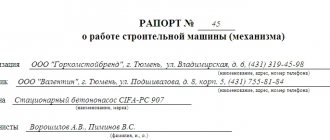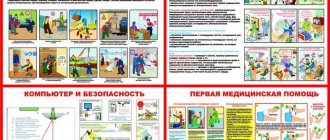Frequency of approval of staff structure
The staffing table should be approved at the very beginning of the business activity of any employer hiring employees (organizations, individual entrepreneurs, and private practitioners). It is from this document that information should be taken about the conditions included in the employment contract under which a new employee will be hired (Article 15, Labor Code of the Russian Federation).
The staffing table is approved by order reflecting the start date of applying the staffing structure. The same order may indicate the validity period of the approved structure if it is known in advance.
Meanwhile, it is not necessary to change the staffing table upon expiration or every year. You can make changes and additions to it, as well as extend the period of use.
However, if there are a large number of changes, working with this document will be inconvenient. The best way out of this situation would be to approve a new schedule. And, of course, a new document on staff structure will need to be approved if there are global changes in the organizational structure of the employer itself, for example, if:
- reorganization;
- significant staff reduction;
- changes in the number of structural units, implying a redistribution of functions between departments and employees;
- updating the approach to material incentives for employees;
- massive changes in the names of positions, specialties, and professions used by the employer.
The last of these reasons, in connection with the transition from 2020 to maintaining work books in electronic form (and, accordingly, to standardizing the information reflected in them), may be significant for those employers who do not adhere to the name provided for by the current classifiers in designating the employee’s labor function :
- professions of workers, positions of employees and tariff categories (OK 016-94) - it was approved by Decree of the State Standard of Russia dated December 26, 1994 No. 367;
- classes (OKZ) OK 010-2014 (MSKZ-08), approved by Order of Rosstandart dated December 12, 2014 No. 2020-st;
- positions of managers, specialists and other employees (approved by Resolution of the Ministry of Labor of Russia dated August 21, 1998 No. 7);
- unified tariff and qualification standards used to determine the jobs and professions of workers by industry;
- professional standards, reference to which in relation to the performed labor function is given by Art. 57 and art. 195.1 Labor Code of the Russian Federation.
A staffing table is formed for the employer as a whole, including data for all its structural units, including separate divisions.
Typical staffing table
cadet corps, subordinate to the Administration of the subject of the federation
developed for the Krasnoyarsk Cadet Corps
Levchenko V.K.
Krasnoyarsk
1999
An innovative State educational institution - the cadet corps of regional (federal subject) subordination - integrates
· a system of educational programs at various levels of II – IY levels of education, implemented in educational institutions of secondary (complete) general education,
· additional education in a wide range of programs (including primary vocational),
· targeted training of students in various profiles of higher educational institutions of the region,
· boarding accommodation and full provision for pupils,
· principles of the military organizational structure, the military way of life of the corps and the education of cadets based on the best traditions of the Russian Army and Russian cadet corps, carried out by trained educational staff of reserve officers of the Russian Army.
The number of students in the cadet corps is 400 - 1000 cadets.
Structural divisions
cadet corps are (Appendix 1):
· educational part,
· laboratory of psychological selection and support of the educational process and professional guidance of students,
· industrial training, educational and artistic workshops, educational and leisure center (club),
· laboratory of technical training aids,
· department of editorial and publishing work (printing house),
· library,
· sports complex (gym or sports base),
· dining room,
· clothing service (service for supplying clothing property and soft equipment),
· service for the operation of buildings, structures and engineering networks (external and internal),
· Regime and security service for organizing the educational process,
· garage (if vehicles are available),
· infirmary and clinic,
· administrative services (personnel department, accounting),
· other units necessary for organizing the educational process (stable, shooting range, swimming pool, etc., if available).
The staffing table was compiled on the basis of the Law of the Russian Federation “On Education”, the standard staff of boarding schools (Prospect of the USSR Ministry of Education No. 166 of 08/31/87), letter of the Ministry of General and Professional Education of the Russian Federation No. 23/146 of 04/22/97, letter of the Ministry of Education of the Russian Federation No. 10/32-t from 01/12/93, UTS of pedagogical workers (Rule of the Ministry of Education and the State Committee for Higher Education No. 463/1268 of 08/31/95) and UTS of works and professions of workers, technical and technical characteristics for general industry positions of employees (Permanent Ministry of Labor of the Russian Federation No. 32 dated November 1, 1992), order of the Ministry of Education No. 420 dated December 1, 1992, additions to the list of TKH (Regulation of the Ministry of Labor of the Russian Federation No. 40 dated March 1, 1993), appendix 1 to order of the Ministry of Health of the Russian Federation No. 55 dated March 30, 1993 (Appendix 1 to Resolution of the Ministry of Labor of the Russian Federation No. 62 of March 22, 1993). and within the competence of the Administration, determined by Article 8 of the Law of the Krasnoyarsk Territory “On Education”.
| № p/p | ETS position | Col. rates | Discharge By ETS | Brief rationale for positions outside of typical staffing levels |
| 1 | 2 | 3 | 4 | 5 |
Administration
| 1 | Corps Director | 1 | 12-16 | |
| 2 | Deputy Director for Academic Affairs | 1 | 11-15 | |
| 3 | Deputy Director for Educational Work | 1 | 11-15 | |
| 4 | Deputy Director for Regime and Safety of the Educational Process | 1 | 11-15 | Organizes and manages the regime service, the pass office, provides round-the-clock security of all buildings, structures and premises, territory, establishes and ensures a fire safety regime, provides internal communications to all divisions and services of the corps. Subordinate to the personnel of the regime service (Appendix 2 - plan of a typical cadet corps with a security and communications scheme) |
| 5 | Deputy Director for Economic Affairs | 1 | 11-15 | Manages food and clothing supplies for students, staff and corps services, all logistics, safety and repair of all buildings and structures, external and internal engineering networks and communications. Provides full and autonomous services for pupils (bath and laundry, transport, household services) |
| 6 | Chief physician | 1 | 10-15 | |
| 7 | Chief Accountant | 1 | 12-15 |
Teaching staff
| 8 | Head teacher of basic education | 2 | 9-14 | Head teacher of basic secondary – organizes the work of the teaching staff of grades 5-9, coordination of programs and plans, class schedules, current work, graduation from general secondary school, Head teacher of full secondary – organizes the specialization of education in graduating classes, preparation for admission to universities, coordination of programs and plans with universities, and conducting final certification. |
| 9 | Methodist | 1 | 8-14 | |
| 10 | Senior Lecturer | 6 | 7-14 | The senior teacher heads the subject-methodological commission created for each educational area |
| 11 | Teacher | * | 7-14 | The number of bets is determined by the curriculum according to established standards |
| 12 | Head of additional education | 1 | 9-14 | Determines the general ideology of additional education in the cadet corps. Organizes ongoing work in the additional education system. |
| 13 | Teacher-organizer of additional education | 1 | 7-14 | Organizes the work of all parts of the additional education system for all students of the cadet corps. Maintains full accounting and control. |
| 14 | Additional education teacher | * | 6-14 | Determined by the curriculum of additional education, the plan of club work and established standards |
Educational staff
| 15 | Educational psychologist | 1 | 8-14 | Composition of the laboratory of psychological selection and support of the educational process and professional guidance of graduates (LPPO) |
| 16 | Teacher-valiologist | 1 | 8-14 | |
| 17 | Teacher-sociologist | 1 | 8-14 | |
| 18 | Head of educational and technical workshops | 1 | 9-14 | Ensures the operation of all types of technical workshops in accordance with the programs of basic (technology) and additional education (technical clubs). Introduced if at least three workshops are available and operating. |
| 19 | Labor instructor | 1-3 | 6-13 | Conducts classes with students in labor classes and in technical creativity circles |
| 20 | Head of educational and artistic workshops | 1 | 9-14 | Ensures the operation of all types of art workshops in accordance with the programs of basic (drawing, sculpture) and additional education (art studios). Introduced if at least three workshops (studios) are available and operating |
| 21 | Instructor-teacher | 1-3 | 6-13 | Conducts classes with students in fine arts classes and in the additional education system. |
| 22 | Head of educational and leisure center (UDC) ) | 1 | 9-14 | Acts as the head of the club. |
| 23 | Musical director | 1-2 | 7-13 | To teach all students to individually play musical instruments |
| 24 | Accompanist | 2-3 | 7-14 | If there are orchestras (brass, vocal-instrumental, string, folk instruments, accordion players, guitarists, etc.) |
| 25 | Head of Physical Education | 1 | 8-14 | He is also the head of physical training and sports of the cadet corps |
| 26 | Trainer-teacher | * | 6-14 | The number of bets is calculated according to the work plans of sports sections and relevant standards |
| 27 | Physical education instructor | 1-2 | 6-13 | Organizer of sports competitions. One rate for the number of pupils 500-700, over 1000 – two rates |
| 28 | Swimming instructor | 1 | 6-13 | If there is a swimming pool on staff |
| 29 | Senior teacher-organizer of pre-conscription training | 1+ * | 8-14 | One bid for the head of the military training cycle of the cadet corps, * - the rates of company commanders are determined by the number of students - there are 100 students in a company, 5 classes |
| 30 | Teacher-organizer of pre-conscription training | 1 | 8-14 | Introduced when the total number of pupils is over 500 or 25 groups |
| 31 | Teacher (senior teacher) | * | 7-14 | A senior educator is introduced in each company Teacher rates are calculated based on the standard rate of 1.5 rates per class department. This takes into account the permanent presence of the teacher with the classroom department |
| 32 | Junior teacher | * | 3 — 6 | For night duty - 4 rates per company, occupying a separate floor of the dormitory building |
Educational support staff
| 33 | Head of the Laboratory of Technical Training Aids | 1 | 9-14 | LTSO (laboratory of technical teaching aids) provides the educational process with all types of modern technical means (video and audio equipment, computers and computer classes, other complex electronic equipment), a video center, duplicating equipment, a radio station, and a film and photo documentary system. Personnel are hired only if technical means are available. |
| 34 | Software Engineer | 1 | 6-11 | |
| 35 | Video engineer | 1 | 6-11 | |
| 36 | Radio technician | 1 | 7-8 | |
| 37 | Film photo technician | 1 | 7-8 | |
| 38 | Laboratory assistant | 3 | 4-5 | |
| 39 | Library Manager | 1 | 9-14 | Calculations are made according to existing standards |
| 40 | Librarian | 1-2 | 6-10 | |
| 41 | Projectionist | 1 | 4-6 | It is introduced in the presence of film projection equipment, an auditorium and systematic film distribution in the cadet corps. |
| 42 | Museum caretaker | 1 | 3-4 | Introduced if there is a museum with compositions and sets of museum relics. |
| 43 | UDC castellan | 1 | 2 | Manager of theatrical wardrobe and props, soft equipment UDC |
| 44 | Club Commandant | 1 | 3-5 | Introduced if there is a separate club building (UDC) |
| 45 | Wardrobekeeper | 1 | 1 | |
| 46 | Head of the sports complex | 1 | 9-14 | If there are several gyms, a swimming pool, sports grounds, a stadium, specialized sports and training complexes) |
| 47 | Commandant of the sports complex | 1 | 3-5 | |
| 48 | Pool Manager | 1 | 3-4 | |
| 49 | Chlorination plant operator | 1-2 | 2 | |
| 50 | Pool castellan | 1 | 2 | |
| 51 | Head of military affairs | 1 | 3-4 | Ensures the operation and improvement of the pre-war training base (shooting range, drill ground, specialized military training classes, country summer training center) |
| 52 | Training unit manager | 1 | 4-6 | |
| 53 | Clerk of LPPO | 1 | 3 |
Composition of the economic part
| 54 | Canteen manager | 1 | 7-13 | |
| 55 | Chef (production manager) | 1 | 6-12 | |
| 56 | Cook (replacement) | * | 4-6 | Change of cooks – 2 for up to 500 students — 3 with the number of pupils 500–1000 Day shifts – three, round-the-clock – four |
| 57 | Pastry chef | 1-2 | 1-6 | |
| 58 | Chef for the production of semi-finished products | 1-2 | 1-6 | |
| 59 | Waiter | * | 2 | Two waiters per 100 cadets |
| 60 | dishwasher | * | 2 | Two rates for washing kitchen utensils Two rates for every 100 pupils |
| 61 | Kitchen helper | * | 2 | Two rates per hundred pupils (including one rate for bread-cutter and butter-cutter) |
| 62 | Manager of food warehouses | 1 | 4-5 | |
| 63 | Storekeeper | 3 | 3 | One storekeeper for each type of food warehouse (meat and dairy, dry products, vegetables) |
| 64 | Forwarder | 1-2 | 3-4 | |
| 65 | Head of clothing supply (head of clothing service) | 1 | 7-13 | Providing pupils with all types of clothing allowances (uniforms and linen, bedding, soft equipment, etc.) |
| 66 | Manager of the central warehouse | 1 | 6 | If a warehouse is created at the corps for centralized servicing of several cadet corps |
| 67 | Storekeeper | 1 | 3 | Uniform warehouses |
| 68 | Castellan | 1-2 | 2 | Pantry for linen and soft equipment |
| 69 | Uniform repair worker | 2-3 | 2 | |
| 70 | Shoemaker | 1-2 | 2 | |
| 71 | Operator for washing clothes (washing machines) | * | 3-4 | One rate per 150 cadets, subject to availability. Requires your own laundry equipment |
| 72 | Ironer | * | 1 | When performing ironing operations in the housing |
| 73 | Hairdresser | * | 3 | One rate per 300 pupils, for every 200 above this one rate |
| 74 | Chief Engineer services for the operation of buildings, structures and engineering communications | 1 | 12-15 | The operation service is introduced by a structural unit in cadet corps deployed on the site of military camps, military schools and construction complexes that have more than 5 separate buildings, a separate territory and are not served by city utilities (water supply, heating networks, sewerage and electricity) |
| 75 | Complex building renovation worker | * | 2-4 | |
| 76 | Gas-electric welder | 1 | 4-6 | |
| 77 | Carpenter | 1 | 4-6 | |
| 78 | A carpenter | 1 | 2-4 | |
| 79 | Storekeeper | 1-2 | 3 | |
| 80 | Street cleaner | * | 2 | One bid per 5000 m2 of territory |
| 81 | Cleaner | * | 2 | One rate per 500 m2 of cleaned area for one-time wet cleaning |
| 82 | Replacement pool electrician | 4 | 4-6 | For medium-length pools (25 m) with round-the-clock water purification for servicing electric pumps, heaters and fan units |
| 83 | Mechanic of external engineering networks | 1 | 5-10 | In the presence of external engineering networks |
| 84 | Electrician | * | 4-6 | One rate per 150 kW of energy consumed by electrical installations |
| 85 | Locksmith - plumber | * | 4-6 | 1.33 rates per 10,000 m2 of premises |
| 86 | Heating engineer | * | 4-6 | One rate for 60,000 m3 of premises, two rates for the maintenance of external heating mains with a length of 1-10 km. |
| 87 | Emergency service mechanic | 4 | 5-6 | Providing 24-hour duty |
| 88 | Commandant of the educational building | * | 3-5 | One staff member for each academic building |
| 89 | Commandant of the Dormitory Corps | * | 3-5 | One staff member for each dormitory building |
Service for the regime and safety of the educational process
| 90 | Senior duty officer | 1 | 8-10 | The scheme for ensuring regime and security, the tasks of the service are given in Appendix 3 |
| 91 | Duty officer | * | 8-10 | The number of bets is determined by the regime and security plan |
| 92 | Watchman | * | 2 | To protect building facilities at night |
| 93 | Head of the Pass Bureau | 1 | 3-4 | Organizes access control, registration of passes |
| 94 | Fire department manager | 1 | 3-4 | Responsible for the state of fire safety, training fire safety corps personnel |
| 95 | Automobile mechanic | 1 | 5-10 | If there is an electromechanical intercom switch |
Medical service
| 96 | Head of the clinic (therapist) | 1 | 10-15 | |
| 97 | Pediatrician | 1 | 10-15 | |
| 98 | Dentist | 1 | 10-15 | |
| 99 | Otolaryngologist | 0,5 | 10 | With a total number of students over 500 |
| 100 | Dermatologist | 0,5 | 10 | |
| 101 | Neuropathologist | 0,5 | 10 | |
| 102 | Surgeon | 0,5 | 10 | |
| 103 | Head nurse | 1 | 6-11 | |
| 104 | Vaccination nurse | 1 | 6-11 | |
| 105 | Clinical nurse | 1 | 6-11 | With a total number of students over 500 |
| 106 | Nurse FTO | 1 | 6-11 | |
| 107 | Doctor's office nurse | 1 | 6-11 | |
| 108 | Nutritionist | 1 | 6-11 | |
| 109 | Sister-hostess | 1 | 2-3 | |
| 110 | Physical therapy instructor | 0.5 | 6-9 | |
| 111 | Head of the infirmary | 1 | 9-12 | |
| 112 | Charge nurse | 4 | 6-11 | |
| 113 | Sister-mistress of the infirmary | 1 | 3 | |
| 114 | Nurse | 3 | 2-3 | |
| 115 | Pool nurse | 1 | 6-11 |
Composition of the administrative service:
| 116 | Clerk | 1 | 3 |
| 117 | Head of HR Department | 1 | 8-12 |
| 118 | HR Specialist | 1 | 5-8 |
| 119 | Lawyer-consultant | 0.5 | |
| 120 | Accountant | 3 | 5-11 |
| 121 | Economist | 0,5 | |
| 122 | Cashier | 1 | 3-4 |
Composition of additional structural divisions
(can only
in the presence of special technical means and material resources)
| 1 | Head of the editorial and publishing department | 1 | 9-14 | Organized only if available complex equipment for the production of printed materials (books, magazines, manuals, teaching materials) for educational purposes (mini-printing presses, resograph with a computer interface, stapler, cutter, etc.) |
| 2 | Proofreading editor | 1 | 5-8 | |
| 3 | Copying equipment operator | 1 | 2-3 | |
| 4 | Compositor | 1 | 3-4 | |
| 5 | Garage Manager | 1 | 7-13 | If you have a fleet of at least 7 cars and boxes |
| 6 | Garage mechanic | 1 | 5-10 | If you have 3-5 vehicles |
| 7 | Driver | * | 4-7 | For each vehicle unit |
| 8 | Head of the sewing workshop | 1 | 7-12 | When organizing independent tailoring of uniforms, it is introduced into the staff of the cadet corps as a structural unit |
| 9 | Workshop staff | * | * | |
| 10 | Stable manager | * | * | When organizing horse training classes |
| 11 | Stable staff | * | * |
Information reflected in the staffing table
A document reflecting the structure of states is never drawn up in relation to specific individuals. It includes information of a generalized nature, and due to this, the staffing table can be used without any special amendments for several years.
The document being created reflects not only all the structural divisions that the employer has at the time of creating the schedule, but also those planned for creation in the near future. For each department, you should show a complete list of those staffing positions that it is supposed to have (including vacant ones), indicating the salary or tariff rate related to the corresponding position, specialty, profession.
In a situation where the designation of a labor function coincides with the wages that characterize it, staffing units that have the same parameters are not singled out individually, but are shown in one line with the number of identical units reflected in this line according to the corresponding column of the schedule.
When indicating the amount of payment for work, it should be remembered that the Labor Code of the Russian Federation (Article 22) requires the establishment of equal payment for work of equal value. Therefore, indicating the range of limits to which the salary can correspond is unacceptable in the staffing table (Letter of Rostrud dated April 27, 2011 No. 1111-6-1).
the treasure for the same position must be the same, and differences in the level of qualifications, complexity and quality of work performed for this position can be regulated by allowances. Accordingly, the staffing table also reflects the amount of allowances and the total amount of wages for each staffing unit highlighted in the document (or units, if their parameters are the same).
Summarizing the information provided in the staffing table makes it possible to find out:
- the total number of staff and the number of employees in specific departments;
- the total volume of the wage fund, highlighting in it the figures that make up the basic part of earnings (in the form of salaries and tariff rates) and the part formed through allowances;
- distribution of payroll and its components among structural units.
In addition, using the current staffing table, you can determine the presence of current vacancies to be filled, both in the entire state and in relation to each of the divisions.
How to draw up a school staffing table based on the model
The development of the document is carried out by the management team of the organization. Before starting work in this direction, it is necessary to issue an order approving the staffing table at the school. An example of an order is available at the link:
Methodological recommendations that were established by the Department of Education are used as the fundamental document for drawing up the schedule. The standard form (N T-3) of the schedule, adopted by the resolution of the State Statistics Committee of the Russian Federation, is filled out taking into account the norms for the number of students of the institution. The organization has the right to supplement the form by adding clarifying information.
A typical staffing table for a comprehensive school usually includes the following sections:
name of the document and period of its validity;
names of departments, list of management personnel, teachers, specialists and service workers;
a list of positions in order corresponding to departments, by seniority;
number of employees by position, including indication of part-time rates.
salaries or tariff schedule under employment contracts;
additional payments in the form of allowances or bonuses, etc.;
the total amount of charges.
It is convenient to divide the form of the staffing grid into several sections according to the number of categories of employees. Administrative positions include the head of the school and his deputies. Pedagogical workers are teachers, life safety teachers, music workers, psychologists, librarians, speech therapists, physical education instructors, tutors, and senior methodologists. Educational positions include counselors, secretaries, cashiers, accountants, laboratory assistants, and supply manager. Service personnel include the positions of cleaners, mechanics, fireman, driver, and cloakroom attendants.
The number of employees in an institution is determined, first of all, by its occupancy and budgeting, as well as taking into account the type of institution, educational programs, and the number of junior and senior classes. For example, the schedule of a school with a standard form of education will differ from documents developed for boarding schools, organizations with in-depth study of individual subjects, or evening (shift) or correctional education institutions.
The content of the document also depends on the characteristics of the establishment regime. So, if a school has more than one shift, additional units of premises cleaners are added to the staff at the rate of one rate per 500 m2.
Form and sample for the staffing table for 2020
There is no mandatory form for the staffing form on which this document should be formed in 2020. You can develop it yourself or use the T-3 form, approved for this purpose. Resolution of the State Statistics Committee of the Russian Federation dated January 5, 2004 No. 1.
The form approved by Resolution No. 1 provides for the reflection in it of all information necessary for the staffing table. If the number of columns in it turns out to be insufficient (for example, to reflect all the data on allowances), then their number can be increased by approving its modified form for use as a staffing table form.
In addition to the main table containing data on the state structure itself, the unified form has fields for:
- the number of this document and the date of its preparation;
- details of the person who approved the structure of the order;
- start date and period of application of the schedule;
- total number of staff units.
The rules for filling out the staffing table given in Resolution No. 1 indicate that:
- the presence of underemployment for a full-time unit is recorded by reflecting in the column dedicated to its quantity, instead of number 1, the coefficient corresponding to the share of employment;
- wages should be shown in accordance with the wage system approved by the employer in an amount corresponding to a full month of work, expressed in rubles, regardless of the method of calculating earnings;
- the applied allowances must be divided by their types, showing among them both those established at the legislative level and those introduced by the employer himself;
- if it is impossible to reflect salaries and bonuses in rubles, they are given with reference to the coefficients, percentages and other methods of calculation used in the calculation.
For necessary reservations, a column is provided for notes. In particular, here it should be reflected how wages that do not have a fixed amount (for example, piecework or hourly) are calculated, with reference to the internal regulations establishing the procedure for calculating earnings using this method.
The formed staffing table is signed by the head of the personnel department and the chief accountant. There is no provision for printing on it, since the document is intended solely for internal use. The employer is not obliged to familiarize employees with it (Letter of Rostrud dated May 15, 2014 No. PG/4653-6-1).
Sample staffing schedule for 2020
Let's sum it up
- The staffing table is one of the main personnel documents, since it reflects the structure of the staff of employees available to the employer. It is compiled at the very beginning of the activity and then, as necessary, supplemented and replaced with new options.
- A document reflecting the staff structure is formed by division. In relation to each of the divisions, information is provided about the positions of employees related to it, the number of these positions, the corresponding base salary and allowances.
- The staffing table does not have a mandatory form for use. Most often, to compile this document, a unified form approved by Goskomstat, or a modified version thereof, is used. The form given in the Goskomstat resolution is accompanied by a description of the rules for applying and drawing up the staffing table.
If you find an error, please select a piece of text and press Ctrl+Enter.









